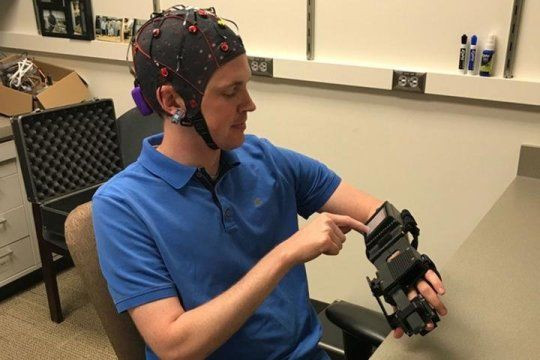Mind-Controlled Device Powered By Brain Signals Helps Stroke Survivors Move Paralyzed Hands
After having a stroke, it’s extremely common for patients to be unable to move certain muscles. Sometimes the paralysis is partial and even temporary, but for others, the impairment can be complete and permanent. Since a stroke damages part of your brain, it’s not an easy feat to learn to move again.
But, a mind-controlled device provided hope for a small group of stroke patients, according to a new study published in the journal Stroke. Ten patients, ages 41 to 72, were able to successfully regain control over some of the movement in their hands while using a device that runs off of electrical brain signals.
Read: Strokes, The Fifth Leading Cause Of Death, Are Mostly Preventable; What To Do
“We have shown that a brain-computer interface using the uninjured hemisphere can achieve meaningful recovery in chronic stroke patients,” study co-senior author Eric Leuthardt said in a news release.

All of the patients suffered a first-time hemispheric stroke at least six months prior to beginning the study. The reason patients at this stage in their stroke recovery were chosen is because survivors typically don’t show too much progress past that point, co-senior author Thy Huskey noted in a statement. All of the patients had motor impairment in their upper limbs that were classified as moderate-to-severe.
There’s not many effective therapies that allow patients to regain motor control in the upper limb after a stroke, the authors write in their paper. Therefore, they decided to test a device called Ipsihand, which was developed by Washington University scientists. The device has two main components: a cap and bionic hand device. The cap fits on the subject’s head and works by detecting electrical signals in the uninjured portion of the brain. The hand brace is placed over the patient’s paralyzed hand and works to detect if the wearer is trying to open or close their hand.
“Of course, there’s a lot more to using your arms and hands than this, but being able to grasp and use your opposable thumb is very valuable,” Huskey said. “Just because your arm isn’t moving exactly as it was before, it’s not worthless. We can still interact with the world with the weakened arm.”
Read: Depression After A Heart Attack May Double Your Risk Of Dying, New Study Finds
Participants were trained on how the device works and were instructed to use it at least five days a week, for 10 minutes to two hours a day. Their motor skills were assessed at the beginning of the study and every two weeks throughout the course of the 12-week study using a standardized approach known as the Action Research Arm Test, as well as other evlaution tools. On average, their scores increased by 6.2 points on a 57-point scale. Although it’s a seemingly small improvement, Leuthardt pointed out just how important it is.
“For some people, this represents the difference between being unable to put on their pants by themselves and being able to do so,” he said. The degree of each patient’s improvement wasn’t reflective of how much time they spent using Ipsihand. Instead, it depended on how well the device translated brain signals into hand movements. To prove the effectiveness of this type of device, larger randomized control studies should be conducted, the authors conclude in their paper.
See also: Heart Attack, Stroke Rates Lower In Places With Trans Fat Bans, Study Says
Strokes Are Now A Young Person's Disease; Why Rates Among Americans 18 to 44 Continue To Rise



























